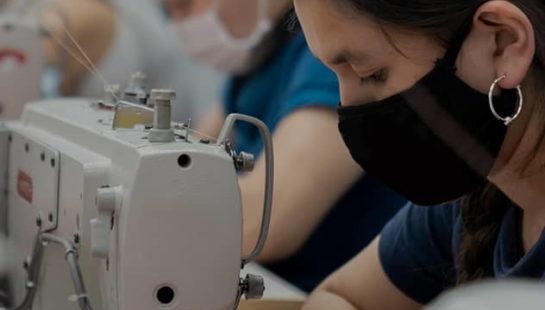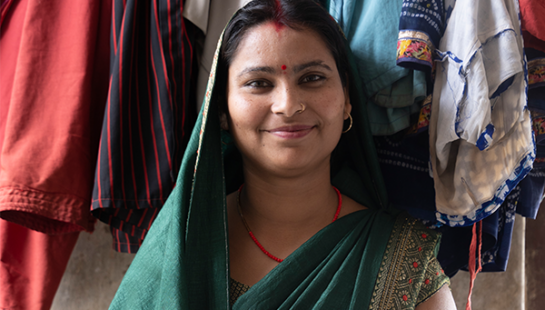The environmental impact of the fashion industry and our consumption habits are overwhelming.
Each year:
• 100 billion new garments are made
• 92 million tonnes of textile waste are produced globally
• 5 to10 per cent of global greenhouse gas emissions are produced by the fashion industry
Hearing stats like this, it seems like we just need to put the brakes on fashion. Stop making new clothes; stop releasing thousands of new styles a year; stop sending textiles to landfill so quickly.
Here in Australia, we buy an average of 56 items of new clothing items each year, and have lots of second-hand shops and marketplaces too. If fashion stopped overnight, we’d be okay for quite a while.
And our planet would breathe a sigh of relief. Tonnes of clothes would no longer be sent to landfill. The emissions from manufacturing and transportation would stop being released. Our waterways would run clearer. Surely, that’s a good news story.
But then we have to stop and think about the 300 million people employed across the fashion supply chain. Is the loss of their job and livelihood good news? If the fashion industry hit the brakes, what kind of dignifying work would be available to workers in its place? How can a steady income be maintained so that workers can keep their kids in school?
It’s clear that fashion needs a makeover to limit its huge environmental burden, but this shouldn’t happen at the expense of workers and their rights. To put it bluntly, putting solar panels on top of a factory filled with people working in conditions of forced labour isn’t true progress. Changing the fashion system is about benefiting both the environment and workers. This is called a ‘just transition’. As the International Labor Organization puts it, as we move towards a system that is better for our planet, let’s take the opportunity to hear from and empower garment workers, and ensure that nobody gets left behind. Sustainable development is progress for people and planet; it will not be truly realised with narrow interventions imposed by companies from the other side of the world to communities that are impacted.
How Can The Industry Make A Just Transition?
Complex systemic change requires all players in the system to make progress together, to ensure that both the process of transition and the outcomes are fair. A Just Transition is built upon the foundations of social dialogue with affected stakeholders to ensure that solutions are holistic. There are steps that companies can take to support a just transition.
Break Down Internal Barriers
Creating holistic change requires a company to take a wider view of their impact and their goals. For example, a sustainability team might set their own decarbonisation targets for factories, but if the production team hasn’t been able to discuss the feasibility of these targets with their suppliers, this can have a negative impact on factory workers and cause strain on supplier relationships and accountability. Siloing responsibilities and initiatives is more likely to result in solutions that don’t work for everyone in the organisation, let alone the supply chain. As a first step, it’s important for companies to establish governance structures of consultation and shared responsibility.
Strengthen Supplier Relationships
Adopting Responsible Purchasing Practices and strengthening relationships with suppliers are important and ongoing steps to ensure that progress towards a greener supply chain is fair and effective. Companies can ensure they are not contributing to undue pressure on workers by forecasting and communicating their order volumes and payment terms with suppliers with fair warning and clarity.
Our 10th Edition Ethical Fashion Report found that only 35% of companies had adopted strong policies and strategies for responsible purchasing. With supply chains that span different regions, it’s important to remember that suppliers are best placed to speak to their own contexts and the kinds of solutions that work best there.
Our 10th Edition Ethical Fashion Report found that only 35% of companies had adopted strong policies and strategies for responsible purchasing.
Listen To Workers’ Voices
Too often, workers and their concerns and experiences are sidelined in the fashion industry. Companies must work on hearing from workers themselves. The first step is to trace their supply chain—85 per cent of companies included in this year’s Ethical Fashion Report had gaps in their tracing of their own supply chains. This means they’re not even fully sure of who is making their clothes, and under what conditions.
Companies also need to regularly audit the conditions that workers experience. And ultimately, companies must invest in robust and reliable channels to hear from workers. Third-party audit reports include only a defined list of questions that may result in gaps in understanding. For example, there is no place in these audit templates to capture the felt experience of a changing climate by workers who may struggle to work during the day due to extreme heat, or travel to work because roads have been washed out by unprecedented floods.
In all of these actions, one theme is clear: companies need to embrace the challenges that come through genuine and respectful collaboration with their own colleagues, suppliers and factory workers. This is not easy work, but it is crucial to protect people and planet.
Companies need to embrace the challenges that come through genuine and respectful collaboration with their own colleagues, suppliers and factory workers.
How Can Everyday Shoppers Support A Just Transition?
Beware of brands that only talk about their sustainability
The pursuit of sustainability without respect for workers could be shallow at best and false at worse. If you see a brand that boasts about its sustainability claims with radio silence on workers in their supply chain, let this raise some alarm bells for you.
Speak out to your favourite brands
Contact the brands you love, using our Speak Out to Brands Tool, to let them know that the environment and workers matter to you—and that you have your eye on how their ethical practices improve.



 Baptist World Aid
Baptist World Aid

 Sophia Russell,
Sophia Russell,